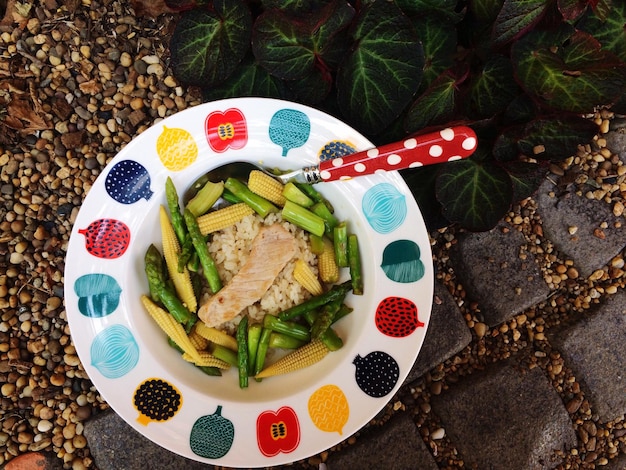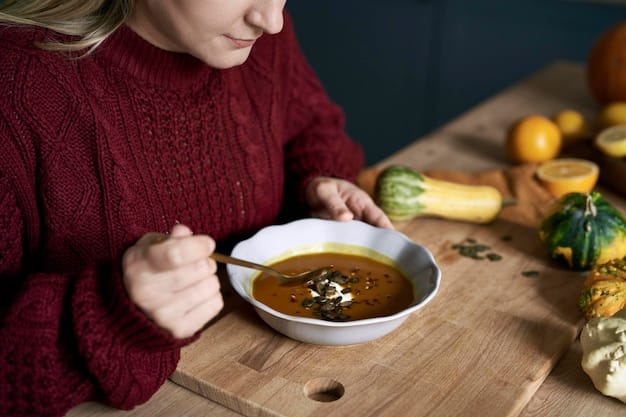Senior Nutrition: Boosting Immunity and Reducing Inflammation by 25% in Winter 2025

Achieving a 25% boost in immunity and reduction in inflammation for seniors by winter 2025 involves a targeted nutritional strategy focusing on foods rich in antioxidants, omega-3 fatty acids, and specific vitamins, alongside lifestyle adjustments for optimal absorption and systemic health.
As winter approaches, concerns about health, particularly immunity and inflammation, rise significantly for seniors. Understanding how
The Science Behind Senior Nutrition and Winter Health
The immune system naturally becomes less robust with age, a phenomenon known as immunosenescence. This makes older adults more susceptible to infections, especially during colder months. Chronic low-grade inflammation, often linked to age-related conditions, further complicates matters by taxing the body’s resources and contributing to various diseases. Nutrition plays a pivotal role in mitigating these age-related changes, offering a controllable lever to enhance health outcomes.
Focusing on specific nutrients can significantly alter the body’s response to environmental stressors and internal inflammatory processes. The goal of a 25% improvement by winter 2025 is ambitious but achievable through consistent dietary changes and an understanding of key nutritional principles.
Understanding Immunosenescence and Its Dietary Links
Immunosenescence is characterized by a decline in both innate and adaptive immune responses. This includes reduced production of new immune cells and diminished function of existing ones. Oxidative stress, which accumulates with age, is a major contributor to this decline. Antioxidant-rich foods can counteract oxidative damage.
- Vitamin C: A powerful antioxidant, essential for immune cell function.
- Vitamin D: Modulates immune responses and reduces inflammation.
- Zinc: Crucial for the development and function of immune cells.
- Selenium: Supports immune system integrity and antioxidant pathways.
Dietary deficiencies in these micronutrients are common among seniors and can exacerbate age-related immune decline. Tailoring dietary intake to meet these specific needs is fundamental for bolstering defenses against winter illnesses.
Inflammation: The Silent Contributor to Age-Related Illnesses
Chronic inflammation is not always obvious, often manifesting as subtle, persistent systemic inflammation. This state contributes to conditions like cardiovascular disease, diabetes, arthritis, and even cognitive decline. Dietary patterns, particularly the consumption of processed foods and unhealthy fats, can fuel this inflammation.
Conversely, certain foods possess potent anti-inflammatory properties that can help quell this internal fire. The aim is to shift the body’s inflammatory balance towards a more pro-resolving state. This involves reducing inflammatory triggers while increasing the intake of anti-inflammatory compounds.
Achieving a 25% reduction in inflammation is a substantial goal, requiring a holistic approach that extends beyond simple food choices to mindful preparation and portion control. It’s about creating a sustained anti-inflammatory environment within the body rather than relying on short-term fixes.
Immunity-Boosting Powerhouses for Winter Resilience
Building a robust immune system for seniors ahead of winter means strategically incorporating foods known for their immune-enhancing properties. These foods work synergistically, providing a broad spectrum of nutrients that support various aspects of immune function.
The focus should be on nutrient-dense options that also offer versatility in meal preparation, making them easier to integrate into daily diets. The consistent consumption of these foods is key to their long-term efficacy.
Citrus Fruits and Berries: Vitamin C Champions
Vitamin C is perhaps the most well-known immune-boosting nutrient. It plays a vital role in white blood cell production and function, and acts as a powerful antioxidant protecting cells from damage. Seniors often underestimate their need for this vitamin, especially during winter.
- Oranges: A classic source, easy to consume as fruit or juice.
- Grapefruits: Also high in Vitamin C and antioxidants.
- Strawberries: Versatile and can be added to cereals, yogurts, or smoothies.
- Blueberries: Packed with antioxidants and beneficial for overall health.
Regular intake of these fruits can significantly contribute to maintaining optimal vitamin C levels throughout the winter season. Fresh options are always preferred over processed forms to maximize nutrient absorption.
Leafy Greens: A Micro-Nutrient Goldmine
Dark leafy greens like spinach, kale, and collard greens are nutritional powerhouses, dense in vitamins A, C, E, and K, as well as folate and various antioxidants. These nutrients are critical for immune system integrity and reducing cellular stress.
Incorporating these greens into daily meals can be done through salads, smoothies, or cooked dishes. Their versatility makes them an excellent addition to almost any meal, ensuring a steady supply of vital micronutrients.
Garlic and Ginger: Nature’s Antibiotics and Anti-inflammatories
For centuries, garlic has been recognized for its immune-boosting properties, attributed to compounds like allicin. Ginger, similarly, is a potent anti-inflammatory and antioxidant, widely used to alleviate cold and flu symptoms.
Both can be easily incorporated into cooking as flavor enhancers while delivering significant health benefits. Fresh garlic and ginger are more potent than their powdered counterparts.

Anti-Inflammatory Superfoods to Calibrate Your Health
Reducing inflammation by 25% by winter 2025 for seniors requires a deliberate dietary shift towards anti-inflammatory foods. These foods contain compounds that actively work to calm the body’s inflammatory responses, promoting overall well-being and reducing the risk of chronic diseases.
The cumulative effect of consistently choosing these foods over pro-inflammatory options is what leads to significant improvements in health markers. It’s about empowering the body’s natural healing processes.
Omega-3 Fatty Acids: The Inflammation Fighters
Omega-3 fatty acids, particularly EPA and DHA, are renowned for their powerful anti-inflammatory properties. They help reduce the production of inflammatory molecules and balance the body’s fat profile.
- Fatty Fish: Salmon, mackerel, sardines, and trout are excellent sources.
- Flaxseeds: Plant-based source of alpha-linolenic acid (ALA), a precursor to EPA and DHA.
- Chia Seeds: Another rich plant-based source of ALA, versatile for various dishes.
Aim for at least two servings of fatty fish per week, or consider daily supplementation with a high-quality fish oil, after consulting with a healthcare provider. The consistent intake of omega-3s is pivotal for their anti-inflammatory effects.
Turmeric: The Golden Spice of Health
Curcumin, the active compound in turmeric, is a potent anti-inflammatory and antioxidant. Its efficacy in reducing inflammation is comparable to some anti-inflammatory drugs, without the side effects.
To maximize absorption, turmeric should be consumed with black pepper (which contains piperine) and a source of fat. It can be added to curries, soups, teas, or smoothies. The consistent use of turmeric in cooking can yield significant anti-inflammatory benefits over time.
Berries and Cherries: Antioxidant and Anti-Inflammatory Power
Beyond their vitamin C content, many berries, especially tart cherries, are packed with anthocyanins, powerful antioxidants that give them their vibrant color and contribute to their anti-inflammatory effects.
Regular consumption of a variety of berries can offer broad protection against oxidative stress and inflammation. They are excellent as snacks, in yogurts, or in desserts.
Beyond Food: Lifestyle Factors Amplifying Nutritional Impact
While diet is central to boosting immunity and reducing inflammation, its full potential is realized when supported by complementary lifestyle factors. These elements work synergistically to enhance nutrient absorption, optimize bodily functions, and reduce overall physiological stress.
Ignoring these factors can diminish the benefits of even the most meticulously planned diet. A holistic approach is essential for achieving a 25% improvement in health markers by winter 2025.
Hydration: The Unsung Hero
Adequate hydration is fundamental for all bodily functions, including nutrient transport, waste elimination, and maintaining immune system health. Dehydration can impair circulation and compromise cellular function, making the body more vulnerable.
Seniors often have a blunted thirst sensation, making conscious hydration efforts even more important. Water, herbal teas, and water-rich fruits and vegetables should form the cornerstone of daily fluid intake. Avoid sugary drinks that can promote inflammation.
Quality Sleep: Restoring and Repairing
Sleep is a critical period for physical and mental restoration. During sleep, the body produces and releases cytokines, proteins that combat infection and inflammation. Chronic sleep deprivation can suppress immune function and increase systemic inflammation.
Aim for 7-9 hours of quality sleep each night. Establishing a consistent sleep schedule, creating a comfortable sleep environment, and avoiding late-night stimulants can significantly improve sleep quality and, by extension, immune and inflammatory responses.
Stress Management: Taming the Internal Response
Chronic stress triggers the release of cortisol, a hormone that, while essential in acute situations, can suppress the immune system and promote inflammation when elevated consistently. Effective stress management is therefore crucial for overall health.
Techniques such as meditation, deep breathing exercises, spending time in nature, and engaging in hobbies can help lower stress levels. For seniors, social interaction and maintaining a sense of purpose also contribute significantly to mental well-being and reduced stress.
Practical Strategies for Implementing Dietary Changes
Translating nutritional knowledge into daily practice can be challenging, especially for seniors. Practical, achievable strategies are essential to ensure sustainable dietary changes that lead to improved immunity and reduced inflammation by winter 2025.
Simplicity, consistency, and enjoyment are key to long-term adherence. It’s not about drastic overhauls but about incremental, positive adjustments.
Meal Planning and Preparation
Pre-planning meals ensures a consistent intake of healthy foods and reduces the temptation for less nutritious options. Batch cooking on weekends can provide healthy meals throughout the week, saving time and effort.
Consider incorporating a variety of colors into each meal to ensure a broad spectrum of nutrients. For example, a plate rich in dark leafy greens, vibrant berries, and lean protein offers diverse benefits.
Smart Snacking
Snacks can be powerful opportunities to boost nutrient intake, or they can undermine health goals if chosen poorly. Opt for nutrient-dense snacks that provide sustained energy and immune support.
- Nuts and Seeds: Almonds, walnuts, chia seeds are great sources of healthy fats and minerals.
- Fresh Fruit: Apples, bananas, and a handful of berries are easy and packed with vitamins.
- Hummus with Veggie Sticks: A good source of protein and fiber, paired with vitamins from vegetables.
Avoid processed snacks high in sugar, unhealthy fats, and artificial ingredients, which can fuel inflammation.
Supplementation: When and How
While a food-first approach is always recommended, certain supplements can help bridge nutritional gaps, especially for seniors with specific dietary restrictions or absorption issues. Key supplements to consider include Vitamin D, B12, and omega-3 fatty acids.
However, supplementation should always be discussed with a healthcare provider to determine appropriate dosages and avoid potential interactions with medications. A personalized approach ensures both safety and efficacy.
Monitoring Progress and Adjusting Strategies
Achieving a 25% improvement in immunity and inflammation by winter 2025 is an ongoing journey that requires monitoring and adjustment. Regularly assessing progress allows for fine-tuning dietary and lifestyle approaches to maximize their effectiveness.
This iterative process ensures that strategies remain relevant and effective as individual needs evolve. It’s about being proactive and responsive to the body’s signals.
Regular Health Check-ups and Biomarker Tracking
Routine visits to a healthcare provider are essential to monitor overall health and track key biomarkers. Blood tests can provide insights into inflammatory markers (like CRP), vitamin D levels, and other indicators of immune function.
Discussing dietary changes and their impact with a doctor or a registered dietitian can provide valuable guidance and ensure that interventions are medically sound and effective. Personalized advice based on individual health status is paramount.
Listening to Your Body
Pay attention to how your body responds to dietary changes. Improvements in energy levels, digestion, sleep quality, and a reduction in aches and pains can all be indicators of reduced inflammation and improved overall health.
If certain foods seem to cause discomfort or adverse reactions, adjust your intake accordingly. The goal is to find a sustainable dietary pattern that supports optimal health without causing distress.
Adapting to Seasonal Needs
Nutritional needs can vary with seasons. In winter, increasing intake of vitamin C and D, strengthening gut health, and prioritizing warm, cooked meals can be beneficial. Adapting dietary choices to seasonal availability of fresh produce also ensures maximum nutrient content.
Maintaining a flexible approach to nutrition allows for continuous optimization of health outcomes. The objective is to build a resilient system capable of navigating seasonal challenges effectively.
| Key Food Group | Benefit for Seniors |
|---|---|
| 🍊 Citrus & Berries | Vitamin C for robust immune cell function. |
| 🐟 Fatty Fish & Seeds | Omega-3s combat inflammation effectively. |
| 🌿 Leafy Greens | Rich in vitamins and antioxidants, crucial for cellular health. |
| 🌞 Vitamin D | Modulates immune responses and reduces systemic inflammation. |
Frequently asked questions about senior nutrition and winter wellness
▼
For seniors aiming to boost immunity, prioritizing foods rich in Vitamin C, like citrus fruits and berries, is crucial. Additionally, incorporating zinc-rich foods such as lean meats and legumes, and ensuring adequate Vitamin D intake, possibly through fortified foods or supplements, are vital for strengthening the immune system against winter ailments.
▼
Reducing inflammation by 25% involves a consistent intake of anti-inflammatory foods. Omega-3 rich foods like fatty fish (salmon, sardines) are key. Turmeric, leafy greens, and brightly colored berries also contribute significantly. Avoiding processed foods, excessive sugar, and unhealthy fats simultaneously helps to diminish inflammatory pathways in the body over time.
▼
Yes, certain supplements can be beneficial, especially when dietary intake is insufficient. Vitamin D is often recommended due to limited sun exposure in winter. Omega-3 fatty acid supplements can further aid in inflammation reduction. Probiotics may support gut health, which is linked to immunity. Always consult a healthcare professional before starting any new supplement regimen.
▼
Hydration is fundamental. Adequate water intake ensures optimal circulation of immune cells and nutrients throughout the body. It also aids in flushing out toxins and reduces the burden on the lymphatic system, which can contribute to reducing systemic inflammation. Seniors should aim for consistent fluid intake, even if thirst cues are diminished, to support overall physiological function.
▼
While some immediate improvements in energy or digestion might be noticed within weeks, significant shifts in immunity and inflammation, such as a 25% reduction, typically require consistent effort over several months. The body needs time to adapt, repair, and rebuild. Long-term adherence to a nutrient-dense, anti-inflammatory diet, combined with healthy lifestyle choices, is essential for lasting benefits.
Conclusion
Achieving a 25% boost in immunity and reduction in inflammation for seniors by winter 2025 is an ambitious yet attainable goal, deeply rooted in strategic nutritional choices and mindful lifestyle integration. By prioritizing foods rich in targeted vitamins, minerals, and anti-inflammatory compounds, alongside consistent hydration, quality sleep, and stress management, older adults can significantly enhance their resilience and overall well-being. This proactive approach to senior nutrition is not just about extending life, but enriching it with vitality, even as the colder months set in.





